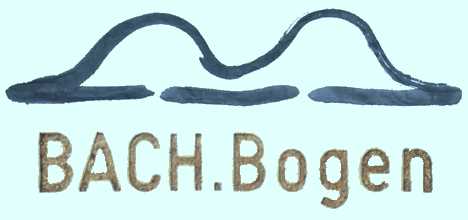Lorin Maazel and Michael Bach in Conversation
Michael Bach
I am publishing this in memory of Lorin Maazel, who died on 13th of July 2014. It is intended to document our meeting held at Gasteig, Munich, along with Andreas Röhn, on 7th of September 1999, when we discussed the BACH.Bow.
Lorin Maazel had become interested in my curved bow when he witnessed my first working session with Mstislav Rostropovich in Berlin in 1998. At the time, he himself was directing his own „Music for Violoncello and Orchestra” in the Berlin Philharmonic concert hall.
My demonstration of the curved bow in Munich was the first occasion on which Lorin Maazel was able to react to this innovation in instrumental technique: and for that reason it marks a historical stage in the development of the BACH.Bogen, especially as two years later I introduced the new model in Paris, which replaced the previous version and is in use today.
On the name ‚Lorin Maazel‘ I composed a piece called „3 Pitches, 11 Sounds” (2000) for violin with curved bow.
Michael Bach: If you wish … you can also play one single line, just one voice, with the bow hairs relatively loose. And this gives of course …
[demonstrating on the cello]
… a different sound.
Lorin Maazel: So, of course – what can I say? One must try it out!
And, it is a question whether I could keep two curved bows at home for some … I do not know, how long I will be in Munich … I stay in Munich another 5 days and in Europe another 10 days. Then I am in the United States and do not come back before January.
But I need only about 2 days, but now I am too busy. But, in principle, this interests me. It would be much better to look at this in January when I will be here for 6 months. Then I will be able, without disruption, maybe during 1 month, to keep 1 to 2 curved bows – and see what I can do with it.
Because, I am a big admirer of Bach, I play all these things, and am always unhappy, with all solutions, I mean the Arpeggios …
My bridge is quite flat, I have a good violin, and I get 3 notes easily, but one is not able to do 4 (laughs).
MB: But 3 notes …
LM: … quite in forte.
MB: … strongly.
LM: And if I should play softly…
(MB demonstrates soft chords in the cello)
LM: You make these bow changes completely skilfully. This cannot be easy … at the tip …
MB: At the tip it is the most difficult. (demonstrates on the cello)
LM: One can hardly make a joint movement, right?
MB: On the violin this is different. But with this bow it goes better… because the position is approximately that of the normal bow. This was the goal. The question is, and so my question to you would be: Should one change something else as well? In fact there are whole fresh prototypes which are just lacquered and still in the test phase.
LM: The real old curved bows, they are not to be used any more, or are they?
MB: I don’t know any of these.
LM: (laughs) They are not …
MB: I have never seen one. So there are sculptures, stone sculptures …
LB: Photographs …
MB: But these curved bows had no mechanics at the grip.
LM: One had to do this with the thumb, then…
I have seen sometimes that one turns around the bow …
MB: Yes, yes, Paganini …
LM: Yes.
MB: … he made such experiments. On the violin this works, on the cello not. He played this way polyphonically. There are sketches by him. Very interesting. I do not know whether you know about this?
LM: Yes, I have seen such a thing. I have also tried such a thing where one holds, actually, the violin and the bow in such a way, one must detach the frog, the violin comes in between (between bow hair and bow stick), and then one plays like this (demonstrates without instrument).
It is astonishing how many notes one can play at the same time.
Why do you have this here …
MB: I must be able to… (demonstrates on the cello) pull up here … with the small finger.
LM: Oh, I see. So one needs …
MB: One needs a hold. Whether it should be so big, this is another question.
LM: So … ah … I have understood. Somewhere the hand must be stable. Then here … and this movement one can make easier. I understand.
MB: The other problem was that the hand could slip. Therefore this stop.
LM: OK, please give me for to play approx. 3 curved bows of different kind. I play with a rather light bow. So, I do not think that it is such a big difference.
But it would interest me. I have a meeting with violinists, … and how this (the curved bow) sounds on a good violin.
MB: (takes another prototype) This bow is better, it offers more support, a better grip. I think, one could make a high curved bow with this grip.
LM: OK, we try this. And then also with this grip. Yes, OK. We do this in such a way. And I will try this because it interests me very much (laughs).
Do you know professor Röhn?
MB: Yes, by name.
(LM gets Mr. Andreas Röhn, concert master of the Munich philharmonic orchestra.)
LM: (to Andreas Röhn) I would like to show you something.
AR: Yes, with pleasure.
LM: This is Mr. Bach, this is Mr. Röhn.
MB: I know your recording of Rudi Stephan’s violin concerto.
AR: Yes, I have played it very often.
LM: An excellent cellist and, he has specialised in BACH.Bows and … it is astonishing … he has designed different models …
(MB demonstrates on the cello)
MB: This is the flat curved bow … and this, the high curved one, …
LM: It is an astonishing sound.
MB: … sounds like that [demonstrates]: four voices up to the tip.
LM: This way one can play chords softly.
AR: Yes, one must be incredibly sure of the left hand.
LM: Until now, I have not really played the curved bow, though I have tried …
AR: I am not able to do it at all …
LM: Yes, but one need touch it only for 2 minutes and then one dares … I have felt it on my hand [LM tried out the curved bow without a violin and used his left hand as a substitute] and, nevertheless, after 2 minutes I have understood a little bit (laughs).
At the beginning one thinks it is not possible at all … and then one realizes, that …
AR: And these are the different models?
MB: Yes, these are all different models.
LM: And with that one can keep the bow under control.


